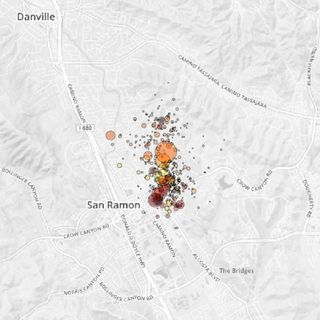Record-Breaking 408 Earthquakes Hit Bay Area City Over Past 2 Weeks

A whopping 408 earthquakes have hit San Ramon, California, in the past two weeks, including 11 in one 24-hour stretch.
This record-breaking earthquake swarm is nothing to fear, however, according to the U.S. Geological Survey (USGS). Periods of tectonic unrest are common in the area and probably don't presage a larger quake, the USGS said.
Most of the quakes affecting this Bay Area city are tiny. The one that kicked off the swarm at 8:50 a.m. Pacific Time on Oct. 13 was a mere magnitude 0.8. People don't usually feel earthquakes until they reach a magnitude of 2.5; quakes between magnitude 2.5 and 5.4 can be felt but rarely cause much damage. Most of the quakes occur at depths of 5 to 6 miles (8 to 9.7 kilometers). [The 10 Biggest Earthquakes in History]
A handful of the San Ramon quakes have rattled locals, including a magnitude-3.6 quake that hit on Oct. 19 and a magnitude-3.1 quake recorded on Oct. 27, both causing weak to light shaking in the East Bay (the eastern part of the San Francisco Bay area). Between 11:30 a.m. PT on Oct. 22 and 11:30 a.m. on Oct. 23, 11 quakes hit the area. Five were between magnitudes of 2.0 and 2.9, and one was a magnitude 3.2.
The quakes are hitting on the north end of the Pleasanton Fault in the Calaveras Fault zone, according to the USGS. Swarms of small earthquakes are common in this fault system. In fact, in 1990, a swarm of 351 earthquakes struck over a 42-day period. The largest quake in that swarm was a magnitude 4.2, a level unlikely to cause serious damage.
The most recent earthquake swarm on this fault system was a 30-day stretch in 2003, over which 120 temblors hit a few miles south of the current quakes. Again, the largest quake was a magnitude 4.2.
"Based on the characteristics of the historical earthquake swarms in this region, the current swarm may continue for several more weeks and is unlikely to be a foreshock to a larger quake," USGS officials said. "East Bay residents may feel shaking from more earthquakes in the magnitude 3-4 range until the swarm abates."
Sign up for the Live Science daily newsletter now
Get the world’s most fascinating discoveries delivered straight to your inbox.
The chance of a serious quake (of magnitude 6.7 or above) hitting the San Ramon area is a mere 8 percent over the next 30 years, the agency estimates. In comparison, the chance of a quake that size occurring somewhere in the Bay Area over the next three decades is 72 percent.
The message, according to the USGS, is to not panic over the current swarm, but to be prepared with an earthquake safety plan for the long term.
Follow Stephanie Pappas on Twitter and Google+. Follow us @livescience, Facebook & Google+. Original article on Live Science.

Stephanie Pappas is a contributing writer for Live Science, covering topics ranging from geoscience to archaeology to the human brain and behavior. She was previously a senior writer for Live Science but is now a freelancer based in Denver, Colorado, and regularly contributes to Scientific American and The Monitor, the monthly magazine of the American Psychological Association. Stephanie received a bachelor's degree in psychology from the University of South Carolina and a graduate certificate in science communication from the University of California, Santa Cruz.
Most Popular

